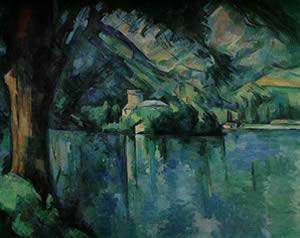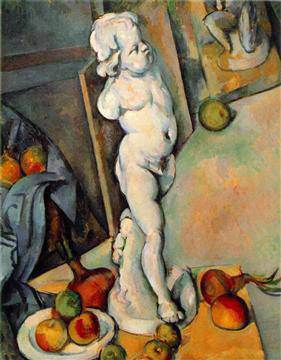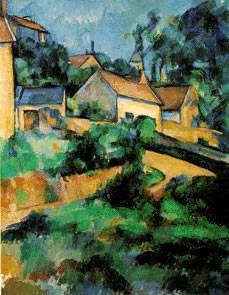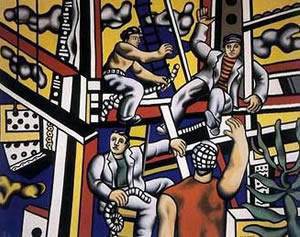
Paul Cezanne – Lac d’Annecy

Paul Cezanne – Still life with Plaster Cupid

Paul Cezanne – Turning Road
The Courtauld Cézannes
On view from 26 June to 5 October 2008 at the Courtauld Institute Galleries, London
]]>
The Courtauld Gallery holds the finest group of works by Paul Cézanne (1839-1906) in Britain. As the culmination of The Courtauld Institute of Art’s 75th anniversary, the Gallery is showing the entire collection together for the first time. The importance of the collection lies not only in its exceptionally high quality but also in its wide range, with seminal paintings, drawings and watercolours from the major periods of the artist’s long career. The Courtauld also holds an important group of nine hand-written letters in which Cézanne reflects upon the fundamental principles of his art. The Courtauld Cézannes, on view from 26 June to 5 October 2008, will be the first opportunity to enjoy this extraordinary collection in its entirety.
The collection includes such masterpieces as the iconic Montagne Sainte-Victoire, c.1887, and Card Players, c.1892-5, which show Cézanne working at the height of his powers. Through such works the exhibition will chart the development of the artist’s revolutionary approach that would later see him acclaimed as the father of modern art. Having been rejected by the official Paris Salon in 1870, Cézanne exhibited at the first Impressionist group exhibition in 1874. However, his work was radically different from that of his contemporaries and found little favour with critics and collectors.
Following his lack of success in Paris, Cézanne withdrew into relative obscurity at his family home near Aix-en-Provence. Here he formed a deep bond with the landscape and the local people, such as père Alexandre, a gardener on his estate who is depicted in both Man with a Pipe and Card Players. The landscape around Aix exerted a powerful influence with the great Montagne Sainte-Victoire taking on an iconic status for the artist. The Courtauld painting is one of the finest examples of Cézanne’s treatment of this subject. When the artist showed this work at a local society of amateur painters in 1895 it was greeted with incomprehension by all but the young poet Joachim Gasquet. Cézanne signed the painting and presented it to him in gratitude. Two years after Cézanne’s death in 1906, Gasquet sold it for the astonishing sum of 12,000 francs. By then Cézanne had been rediscovered by the young avant-garde, including Emile Bernard with whom the letters now at The Courtauld Gallery were exchanged. In one of these Cézanne famously advised his protégé to “treat nature in terms of the cylinder, the sphere and the cone”. This celebrated statement would become a theoretical underpinning for the move towards abstraction in the twentieth century. In a further letter sent shortly before his death he wrote poignantly, “I have sworn to die while painting, rather than sinking into thedegrading senility that threatens old men”.
The majority of The Courtauld Gallery’s collection was put together by the industrialist Samuel Courtauld (1876-1947) and formed part of his founding gift that established the Courtauld Institute of Art in 1932 as the first centre in Britain dedicated to the study of art history. Courtauld assembled his collection of Cézannes between 1923 and 1929 at a time when the artist was regarded with hostility and suspicion by the British art establishment. It was only in 1925, at Samuel Courtauld’s insistence and with his financial support, that the national collections were able to acquire their first painting by the artist.
Courtauld’s conversion to the art of Cézanne came in 1922 when he visited an exhibition at the Burlington Fine Arts Club in London entitled The French School of the Last Hundred Years. He wrote later of his epiphany, “At that moment I felt the magic, and I have felt it in Cézanne’s work ever since”. The following year he bought, for his private collection, one of the most important and complex of Cézanne’s late still lifes, Still life with Plaster Cupid, c.1894 Its radical distortion of perspective challenged the conventions of Western painting and prefigured the advent of cubism. A similarly experimental approach is evident in Lac d’Annecy. Cézanne painted this work while on holiday in the Haute-Savoie in 1896, writing dismissively of the conventional beauty of the landscape as “a little like we’ve been taught to see it in the albums of young lady travellers”. He rejected such conventions, seeking not to replicate the superficial appearance of the landscape but to express what he described as a “harmony parallel with nature” through a new language of painting.
Courtauld bought works which he responded to personally and intuitively, rather than according to art-historical principles. In addition to major canvases, a number of outstanding watercolours were also purchased. Apples, Bottle and Chairback is a supreme example of Cézanne’s mastery of the watercolour medium and is remarkable particularly for its scale and complex luminous washes of brilliant colour.
As well as celebrating The Courtauld Gallery’s exceptional collection of works by Cézanne, this exhibition and its catalogue will present the findings of a major new technical research project on the artist’s Courtauld oils and watercolours conducted in the Courtauld Institute of Art Department of Conservation. Using the very latest imaging technologies, this research has provided fresh insights into the artist’s working methods and techniques, in particular hisexperimental use of colour and line. The fully illustrated catalogue will include essays and individual entries as well as facsimiles of all the letters with new translations.
Follow us on:


